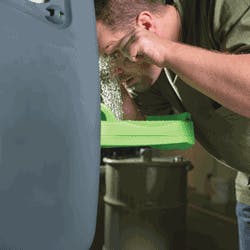Seeing The Benefits Of Secondary Eyewash Stations
Most safety managers are aware of the basic requirements for primary emergency eyewash stations. ANSI Z358.1 calls for eyewash stations to be present anywhere that chemicals or caustics are present. The station should be located within a 10-second walk of the chemical, and capable of delivering a 15-minute flush of both eyes in the event of contact.
When contact occurs, every second counts. Immediately flushing the eyes is the most effective way to remove harmful substances and to ensure the best possible outcome. If treatment is delayed – even by seconds – the effects can escalate from temporary conditions to permanent blindness.
Mounting emergency eyewash stations in confined, remote or electrified locations poses inherent challenges. As a result, noncompliance remains high. In fact, it's estimated that eyewash compliance is only 50 percent in U.S. workplaces overall. Yet the cost of noncompliance is significant.
More than 2,000 eye injuries occur every day in the American workplace, and in 2012 nearly 24,000 of those injuries required days away from work, according to the U.S. Bureau of Labor Statistics. Furthermore, the National Safety Council estimates that the average cost of a lost-time injury is nearly $30,000. When safety managers implement the proper type of eyewash-delivery system for the work area, coupled with the safest ophthalmic flushing fluid, they can improve outcomes and reduce costs related to workplace eye injuries.
Certain environments, such as confined spaces or vehicles, are exempt from ANSI's requirement for primary eyewash stations because such stations are too large, heavy or impractical to install. Personal eyewash bottles are a common solution to making eyewash available where primary stations are difficult to fit. Also known as secondary bottles, these small, portable bottles contain saline and are considered by ANSI to be suitable for flushing the eyes in the case of contact with nuisance particles such as pollen, dust, sawdust or smoke.
However, personal bottles have limited capacity, typically ranging in volume from 1 to 32 ounces, are capable of delivering only up to approximately three minutes of fluid and only can flush one eye at a time. For these reasons, personal bottles do not meet ANSI standards for treating eyes that have come in contact with harmful chemicals or caustics.
When it comes to locations where installing a primary station is impossible, or where the chance for exposure to chemicals is slight, OSHA's Instruction STD 01-08-002 calls for secondary eyewash stations to be present. Even so, many safety managers are not aware of the high value and added convenience that secondary eyewash stations deliver.
Unlike personal bottles, secondary eyewash stations are capable of delivering 1 gallon or more of fluid to both eyes at the same time. Because of their smaller size, lighter weight and increased portability over primary stations, secondary stations can be located in many challenging workspaces that are unsuitable for primary stations. Consequently, secondary stations are ideal for industries with confined spaces, vehicle fleets or field locations, such as construction, utilities, chemical transportation, agriculture, airlines and airfield operations, oil fields and more.
This article looks at some of the work environments where secondary eyewash stations are an ideal solution, and discusses some best practices for implementing secondary stations.
Confined Spaces
Take a confined space such as a janitorial closet. Typically stocked with a variety of harsh cleaning agents containing corrosive chemicals, these workspaces also might contain concentrated chemical solutions that must be mixed prior to use, as well as liquids that are flammable or combustible.
Such hazards pose significant risks to the eyes through chemical splash, spills and harmful vapors. Yet despite the hazards present, size constraints usually do not allow for a primary station to be mounted here. A secondary station, which is much smaller and lighter, is an ideal solution.
Battery-Charging Stations
Battery-charging stations are another area where secondary eyewash stations can be a perfect fit. Busy hubs for small and midsize industrial vehicles, these locations contain a variety of hazards brought on by the lead-acid or nickel-iron batteries charged there. The oxygen and hydrogen gases emitted during charging can be highly volatile and, in the case of overcharging, concentrations can become explosive. In addition, the batteries contain corrosive chemicals such as sulfuric acid, which can leak or spill.
Forklift operators or other individuals responsible for charging battery-powered vehicles often are not protected properly from these hazards, and eyewash stations commonly are missing as well. Exposure to a leak, spill or explosion can result in permanent vision loss to the employee and significant expense to the company. If a primary eyewash station cannot be installed, a secondary station should be placed within an unobstructed 10-second walk of the chemical hazards there.
Field Locations
Field locations in construction, off-site storage, pumping stations, utility hubs and chemical carriers are other common places where eyewash noncompliance is high. The reasons range from simple oversight to infrequent visits, lack of plumbing or an unwillingness to invest in multiple primary eyewash stations for multiple remote locations. In areas where the potential risk of employee exposure to chemicals is low or visits to the site are infrequent, OSHA notes that the site can be evaluated for the installation of a secondary station rather than a primary one.
Vehicles are another easily forgotten location where chemical exposure could occur. Primary eyewash units typically are not an option on the road because of space constraints, difficulty in mounting and vibration, which can cause accidental operation. Most often, if eyewash is available in a vehicle, it is in the form of personal bottles. There are new options in secondary stations that feature vehicle-mounting capabilities with a specialized design that prevents accidental activation. Mounting a secondary station in a vehicle also can eliminate the need to install duplicate eyewash stations at numerous remote sites.
Electrified Environments
Some secondary stations are an appropriate solution to providing eyewash in electrified environments. Since water conducts electricity, it generally is not safe to have any fluids near electrified equipment or components. Yet hazards to the eyes often exist in such work areas, and eyewash should not be overlooked as an essential first aid resource here.
In environments with electrical current or those where water poses a risk to equipment, look for a secondary unit that is self-contained. Such units feature a reservoir into which wastewater is captured and contained until it can be properly and safely disposed of, eliminating the risk of spills, shock and electrocution.
Sterile Solution
Portable eyewash stations typically contain water treated with an additive or some form of saline. While ANSI mandates the minimum performance and use requirements for emergency eyewash, the Food and Drug Administration regulates the manufacture and contents of eyewash solution. FDA requires that all fluid used to cleanse the eyes should be sterile and suitable for safe use in the eye. However, not all flushing fluids available today are sterile.
Only sterile saline is free from living bacteria, organisms and other contaminants. Saline that is sterile, buffered and pH-balanced to match that of human tears minimizes the likelihood of irritation, infection or allergic reaction and therefore maximizes the chance for a positive outcome. It also reduces employers' risk of liability if further injury results. When selecting flushing fluid for secondary stations, look for fluid that is sterile and registered with FDA as an ophthalmic product with a National Drug Code.
Best Practices
Always install, use and maintain secondary eyewash stations in accordance with the manufacturer's guidance. Since eyewash stations are gravity-fed, they must be mounted above the ground in order to operate, and they should be located as close to the chemical hazard as possible.
Workforce training is another important strategy to promote the best possible outcome. By conducting training on a regular basis, employers help ensure that the workforce is familiar with operation of eyewash stations so that when an accident happens they know where to go and what to do. Training also is an effective way to reduce tampering and costly false activations.
Curiosity is a leading reason why workers tamper with eyewash stations, and the best way to satisfy curiosity is through education. Training videos are one good way to satisfy curiosity; another is to purchase extra cartridges and activate the eyewash during training so everyone can see how they work. Eyewash training should be conducted for all new hires as well as during routine employee safety training.
Finally, be sure to maintain secondary eyewash stations according to the manufacturer's instructions. Stations typically require a visual check for system readiness as well as cleaning, disinfecting and changing the flushing fluid every three to six months. Sealed cartridge devices containing sterile or buffered saline require the least maintenance and remain free of bacteria and contamination for up to 24 months. For even greater convenience, disposable secondary eyewash stations are entering the market. Capable of delivering six minutes of sterile fluid, the cartridges have a shelf life of two years, require no other maintenance and feature a waste-containment system for safe use even in electrified environments.
Ensuring the availability of emergency eyewash is crucial to protecting your workforce and supporting productivity. Given the various benefits that secondary stations deliver, they are well-suited for a wide range of applications. Once a thorough hazard assessment has been conducted, you might find that secondary eyewash stations are an ideal way to make eyewash available in places where primary eyewash is too difficult to fit or mount. With a solid understanding of eyewash requirements and careful planning, you can actively support your company's vision for a successful safety culture.
Kelly Piotti is senior product manager for emergency eyewash, Honeywell Safety Products.

